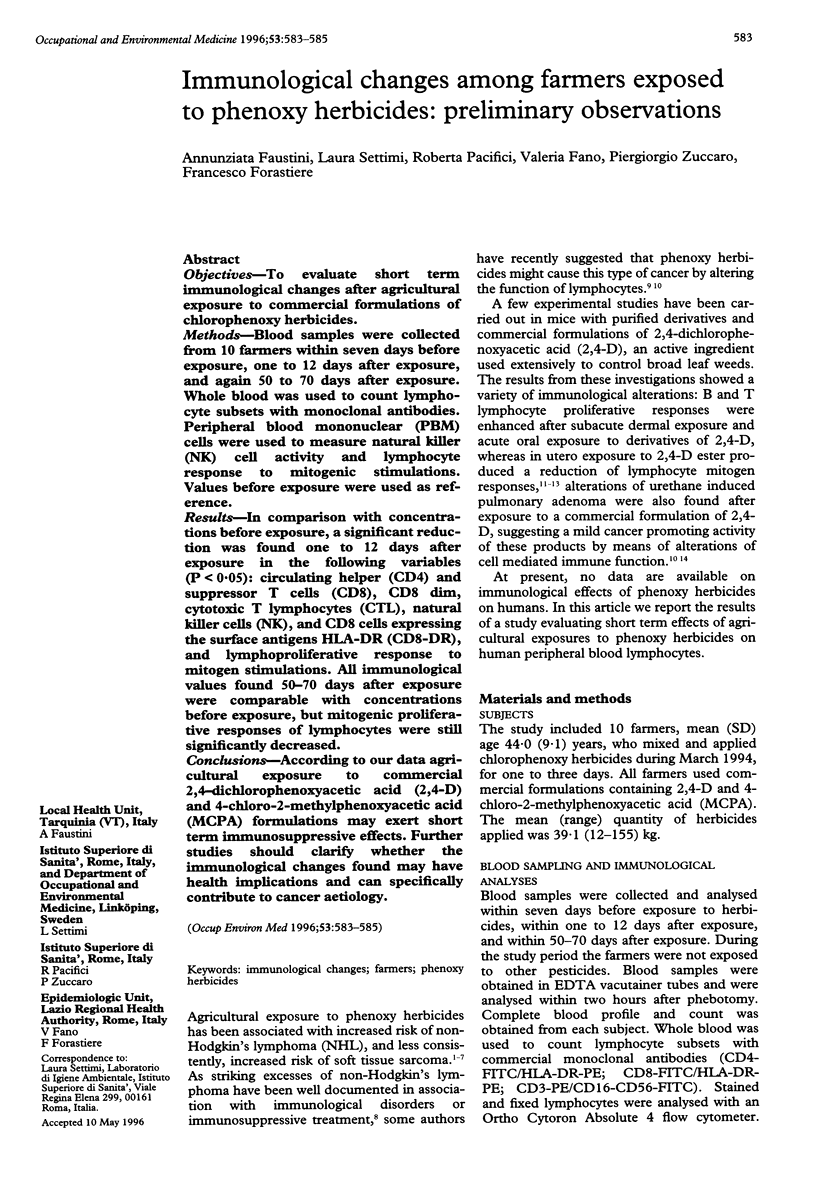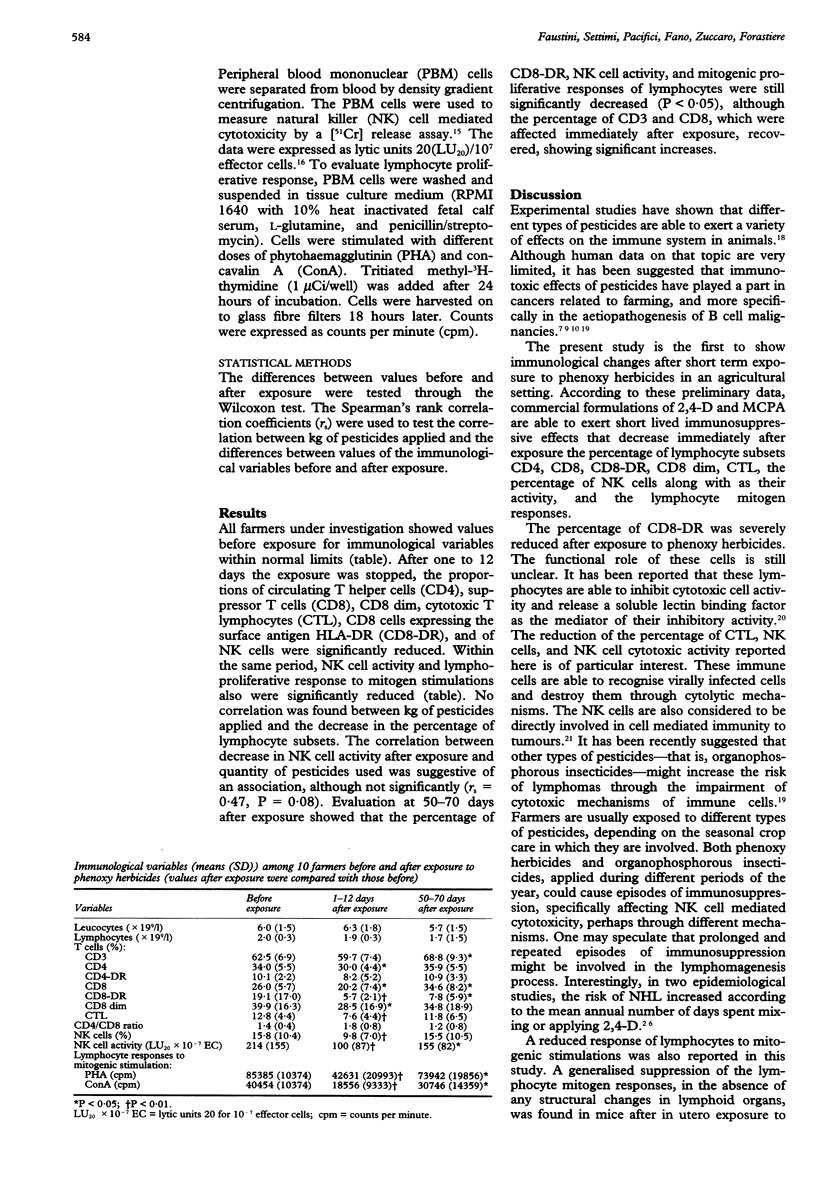Abstract
OBJECTIVES: To evaluate short term immunological changes after agricultural exposure to commercial formulations of chlorophenoxy herbicides. METHODS: Blood samples were collected from 10 farmers within seven days before exposure, one to 12 days after exposure, and again 50 to 70 days after exposure. Whole blood was used to count lymphocyte subsets with monoclonal antibodies. Peripheral blood mononuclear (PBM) cells were used to measure natural killer (NK) cell activity and lymphocyte response to mitogenic stimulations. Values before exposure were used as reference. RESULTS: In comparison with concentrations before exposure, a significant reduction was found one to 12 days after exposure in the following variables (P < 0.05): circulating helper (CD4) and suppressor T cells (CD8), CD8 dim, cytotoxic T lymphocytes (CTL), natural killer cells (NK), and CD8 cells expressing the surface antigens HLA-DR (CD8-DR), and lymphoproliferative response to mitogen stimulations. All immunological values found 50-70 days after exposure were comparable with concentrations before exposure, but mitogenic proliferative responses of lymphocytes were still significantly decreased. CONCLUSIONS: According to our data agricultural exposure to commercial 2,4-dichlorophenoxyacetic acid (2,4-D) and 4-chloro-2-methylphenoxyacetic acid (MCPA) formulations may exert short term immunosuppressive effects. Further studies should clarify whether the immunological changes found may have health implications and can specifically contribute to cancer aetiology.
Full text
PDF


Selected References
These references are in PubMed. This may not be the complete list of references from this article.
- Adams S. L., Horvat S. T., Irwin A. E., Junkin R. W., Koreman N. M., Blakley B. R. The effects of Tordon 202c exposure on urethan-induced lung adenoma formation in female CD-1 mice. Vet Hum Toxicol. 1991 Jun;33(3):209–211. [PubMed] [Google Scholar]
- Blair A., Zahm S. H., Pearce N. E., Heineman E. F., Fraumeni J. F., Jr Clues to cancer etiology from studies of farmers. Scand J Work Environ Health. 1992 Aug;18(4):209–215. doi: 10.5271/sjweh.1578. [DOI] [PubMed] [Google Scholar]
- Blakley B. R., Blakley P. M. The effect of prenatal exposure to the n-butylester of 2,4-dichlorophenoxyacetic acid (2,4-D) on the immune response in mice. Teratology. 1986 Feb;33(1):15–20. doi: 10.1002/tera.1420330104. [DOI] [PubMed] [Google Scholar]
- Blakley B. R., Gagnon J. M., Rousseaux C. G. The effect of a commercial 2,4-D formulation on chemical- and viral-induced tumor production in mice. J Appl Toxicol. 1992 Aug;12(4):245–249. doi: 10.1002/jat.2550120406. [DOI] [PubMed] [Google Scholar]
- Blakley B. R., Schiefer B. H. The effect of topically applied n-butylester of 2,4-dichlorophenoxyacetic acid on the immune response in mice. J Appl Toxicol. 1986 Aug;6(4):291–295. doi: 10.1002/jat.2550060411. [DOI] [PubMed] [Google Scholar]
- Blakley B. R. The effect of oral exposure to the n-butylester of 2,4-dichlorophenoxyacetic acid on the immune response in mice. Int J Immunopharmacol. 1986;8(1):93–99. doi: 10.1016/0192-0561(86)90077-9. [DOI] [PubMed] [Google Scholar]
- Hardell L., Eriksson M., Lenner P., Lundgren E. Malignant lymphoma and exposure to chemicals, especially organic solvents, chlorophenols and phenoxy acids: a case-control study. Br J Cancer. 1981 Feb;43(2):169–176. doi: 10.1038/bjc.1981.25. [DOI] [PMC free article] [PubMed] [Google Scholar]
- Hardell L., Eriksson M. The association between soft tissue sarcomas and exposure to phenoxyacetic acids. A new case-referent study. Cancer. 1988 Aug 1;62(3):652–656. doi: 10.1002/1097-0142(19880801)62:3<652::aid-cncr2820620334>3.0.co;2-4. [DOI] [PubMed] [Google Scholar]
- Herberman R. B., Bartram S., Haskill J. S., Nunn M., Holden H. T., West W. H. Fc receptors on mouse effector cells mediating natural cytotoxicity against tumor cells. J Immunol. 1977 Jul;119(1):322–326. [PubMed] [Google Scholar]
- Hoar S. K., Blair A., Holmes F. F., Boysen C. D., Robel R. J., Hoover R., Fraumeni J. F., Jr Agricultural herbicide use and risk of lymphoma and soft-tissue sarcoma. JAMA. 1986 Sep 5;256(9):1141–1147. [PubMed] [Google Scholar]
- Kelly S. J., Guidotti T. L. Phenoxyacetic acid herbicides and chlorophenols and the etiology of lymphoma and soft-tissue neoplasms. Public Health Rev. 1989;17(1):1–37. [PubMed] [Google Scholar]
- Newcombe D. S. Immune surveillance, organophosphorus exposure, and lymphomagenesis. Lancet. 1992 Feb 29;339(8792):539–541. doi: 10.1016/0140-6736(92)90349-8. [DOI] [PubMed] [Google Scholar]
- Sadat-Sowti B., Debré P., Idziorek T., Guillon J. M., Hadida F., Okzenhendler E., Katlama C., Mayaud C., Autran B. A lectin-binding soluble factor released by CD8+CD57+ lymphocytes from AIDS patients inhibits T cell cytotoxicity. Eur J Immunol. 1991 Mar;21(3):737–741. doi: 10.1002/eji.1830210329. [DOI] [PubMed] [Google Scholar]
- Seaman W. E., Gindhart T. D., Blackman M. A., Dalal B., Talal N., Werb Z. Suppression of natural killing in vitro by monocytes and polymorphonuclear leukocytes: requirement for reactive metabolites of oxygen. J Clin Invest. 1982 Apr;69(4):876–888. doi: 10.1172/JCI110527. [DOI] [PMC free article] [PubMed] [Google Scholar]
- Trinchieri G. Biology of natural killer cells. Adv Immunol. 1989;47:187–376. doi: 10.1016/S0065-2776(08)60664-1. [DOI] [PMC free article] [PubMed] [Google Scholar]
- Vineis P., D'Amore F. The role of occupational exposure and immunodeficiency in B-cell malignancies. Working Group on the Epidemiology of Hematolymphopoietic Malignancies in Italy. Epidemiology. 1992 May;3(3):266–270. doi: 10.1097/00001648-199205000-00014. [DOI] [PubMed] [Google Scholar]
- Wigle D. T., Semenciw R. M., Wilkins K., Riedel D., Ritter L., Morrison H. I., Mao Y. Mortality study of Canadian male farm operators: non-Hodgkin's lymphoma mortality and agricultural practices in Saskatchewan. J Natl Cancer Inst. 1990 Apr 4;82(7):575–582. doi: 10.1093/jnci/82.7.575. [DOI] [PubMed] [Google Scholar]
- Woods J. S., Polissar L., Severson R. K., Heuser L. S., Kulander B. G. Soft tissue sarcoma and non-Hodgkin's lymphoma in relation to phenoxyherbicide and chlorinated phenol exposure in western Washington. J Natl Cancer Inst. 1987 May;78(5):899–910. [PubMed] [Google Scholar]
- Zahm S. H., Weisenburger D. D., Babbitt P. A., Saal R. C., Vaught J. B., Cantor K. P., Blair A. A case-control study of non-Hodgkin's lymphoma and the herbicide 2,4-dichlorophenoxyacetic acid (2,4-D) in eastern Nebraska. Epidemiology. 1990 Sep;1(5):349–356. doi: 10.1097/00001648-199009000-00004. [DOI] [PubMed] [Google Scholar]


